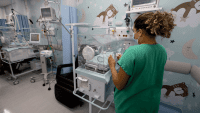In theory, evidence-informed practice makes perfect sense. The challenge is putting it into practice. How do you create a practice environment supported by current scientific evidence? How do you acquire the skills to make the link between questioning your practice and implementing changes that reflect state-of-the-art nursing science? Nurses at Sinai Hospital of Baltimore faced—and met—these challenges by using a systematic approach consisting of six steps.
Step 1: Conduct a focus group
We invited nurses in leadership and direct-care roles to attend a four-hour focus group session. As we told participants, our goal would be to select an evidence-informed model consistent with the philosophy, vision, and mission of the organization and supported by our patient-care delivery model. Before the focus group, we assigned articles on evidence-informed practice and specific models to the participants. As an incentive, we offered continuing education credit for the session.
During the session, we presented a variety of evidence-informed practice models that could serve as blueprints for moving from concept to action. Each model had a detailed diagram to help nurses better understand the process of identifying clinical and administrative problems, implementing solutions, and evaluating the solutions. The elements of the different models varied, but most included these stages:
• establishing an answerable question based on some catalyst or trigger
• critically reviewing and synthesizing evidence from the literature and other sources
• translating evidence into practice
• evaluating and maintaining the change in practice to make sure it’s appropriate and sustainable.
Step 2: Select a model
After an overview of each model and a discussion of its positive and negative characteristics, we asked participants to evaluate the models, using an instrument that measures key attributes, including the following:
• intuitive nature
• ease of understanding
• alignment with organizational vision, mission, and philosophy
• alignment with patient-care delivery model
• requirement for evidence rating.
The group gave very high marks to the Iowa Model and the Rosswurm & Larrabee Model. Eventually, based on overall scores and more discussion, the group selected the Rosswurm & Larrabee Model as the model to guide evidence-informed practice at Sinai Hospital of Baltimore.
Step 3: Communicate
After selecting a model, we made presentations to patient-care leadership groups and nursing practice councils. Our intent was to gain organizational support for the model and to begin integrating it into all aspects of nursing practice.
We also e-mailed the model with supplementary teaching points to all nurse managers, patient-care directors, advanced practice nurses, and the Chief Nursing Officer. We asked nursing managers to post the model on their bulletin boards and asked members of the clinical practice council nursing research committee to serve as resource contacts.
Step 4: Educate
Next, we developed several general one-hour education sessions to share the new model with all members of the healthcare team. Sessions reinforced existing knowledge about evidence-informed practice and provided specific information about the selected model.
To reach as many direct-care nurses as possible, we offered several 30-minute update sessions for day and night shifts. These brief, direct, and intense sessions were designed to provide nurses with a basic understanding of the model and to explain when to implement it and who to contact when questions arise. We also offered several classes to familiarize nurses with point-of-care information resources, including OVID, MedLine, CINAHL, and Up-To-Date.
Step 5: Implement the model
Implementation began with training sessions for members of select practice councils and committees responsible for policy development and research. The model was and continues to be used to evaluate evidence from many sources for the purposes of creating and updating policies. We also developed an instrument for critical analysis to accompany the model.
Recently, the organization used the model to revise the policy on administering I.V. contrast media to patients in special procedure areas. The model helped guide the nurses through the implementation stage. They will use the model again to make sure the change is properly evaluated and integrated into the hospital’s standards.
Step 6: Evaluate the model
Several processes are underway to evaluate the effectiveness of the model and to determine if the model meets the organization’s needs. Evaluation methods include the following:
• an electronic survey (Survey Monkey) to determine nurses attitudes about the model
• a review of outcomes associated with policies, procedures, and protocols revised using the model as a guide
• a focus-group discussion with nurses from the various committees charged with formulating policy and practice.
Blueprint for success
These six steps provide a blueprint for successfully establishing a culture of care based on scientific research. By using it, an organization can determine which model meets its needs. But no matter which model an institution selects, one thing is certain: Its patients will be receiving care based not only on clinical experience, intuition, or ritual, but on sound scientific evidence.
Kenneth J. Rempher, PhD, RN, MBA, CCRN, APRN, BC is Director, Professional Nursing Practice at Sinai Hospital of Baltimore.


















2 Comments.
This sounds all well and good, but, I want to know how to get nurses at the bedside to do this.
This article does not share specific useful steps toward this end.
Success is spelled incorrectly in the title of this article.